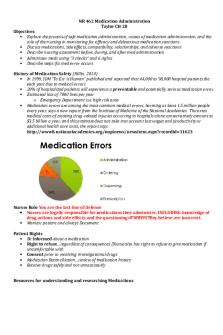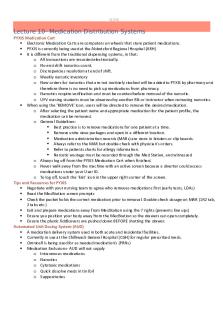Medication Administration PDF

| Title | Medication Administration |
|---|---|
| Author | miranda lee |
| Course | NPP: Advanced Healing Arts |
| Institution | Georgian College |
| Pages | 6 |
| File Size | 161.7 KB |
| File Type | |
| Total Downloads | 61 |
| Total Views | 131 |
Summary
Lab prep questions and answers...
Description
LEARNER PREPARATION – MEDICATION ADMINISTRATION
·
Review CHAPTER 33 MEDICATIONS in the Fundamentals of Canadian nursing (Kozier et al., 2018, pp. 792-874).
QUESTIONS 1. List the different types of medication preparation and a brief description of the preparation e.g. elixir - sweetened oral solution which contains alcohol. Type
Preparation
Aerosol, spray or foam (lozenge)
A flat, round or oval preparation that dissolves and releases a drug when held in mouth.
Aqueous solution (ointment)
Semi solid preparation used for application to skin and mucous membranes.
Aqueous suspension (Paste)
Like an ointment but thicker and stiff. Penetrates skin less than an ointment.
Caplet (pill)
One or more drugs mixed with a cohesive material. (round, oval or flattened shapes).
Capsule (powder)
Finely ground drug(s), some used internally some externally
Cream (suppository)
One or several drugs mixed with a firm base such as gelatin. Shaped for insertion into body(rectum). Base dissolves gradually at body temp which releases drug
Elixir (syrup)
An aqueous solution of sugar, often used to disguise the taste of unpleasant drugs.
Extract (tablet)
Powdered drug compressed into hard small disc. Some readily broken along line, others coated to prevent dissolving in stomach.
Gel (tincture)
And alcoholic or water and alcohol solution. Prepared from plants.
Liniment (transdermal patch)
Semi permeable membrane in form of disc contains drug to be absorbed through skin over long period of time.
Lotion
Liquid suspension applied to skin.
2. Using your textbook and CNO practice standard define the following types of medication orders:
a. Direct order - Apply to one client b. Directive - apply to more than one client c. Stat order - A single order of medication to be administered immediately and only once. d. Single order - A one time order of medication to be given once at a specified time. e. Standing order - A written and approved document containing rules, policies, procedures and regulations. May have no termination date or carried out for specified number or days. f.
PRN order - An “as needed” order which permits the nurse to give medication when in the nurses judgement the patient requires it.
g. Protocol order - a set of criteria and orders under which a medication is to be administered. Ex. insulin protocols.
3.
Watch the CNO webcast Medication Practice Standard: An Overview Webcast http://www.cno.org/en/learn-about-standards-guidelines/educationaltools/webcasts/medication-practice-standard-an-overview-webcast/ What is “critical inquiry” and how is it important to the practice of medication administration? What are some questions the nurse might ask him/herself?
Critical inquiry expands on the concept of critical thinking, asking good questions and reflecting on your practice when making decisions. Ex. Am I giving the right amount of medication? (although there is an order a doctor could make a mistake on the amount of medication that is supposed to be given to patient). Take into consideration high weight and what the med is.
4.
According to the College of Nurses of Ontario [Medication, 2017] there are three principles that promote public protection. State the three principles and explain how the nurse demonstrates each of these. 1. Authority - must have necessary authority to perform medication practices. Accepting an order for medication that is clear, complete and appropriate would be an example. 2. Competency - Nurses ensure that they have the knowledge, skill and judgment needed to perform medication practices safely. An example of this would be assessing the appropriateness of the medication practice by considering the client, the medication and the environment. 3. Safety - Nurses promote safe care, and contribute to a culture of safety within their practice environments, when involved in medication practices. seeking information from the client about their medication, as needed and providing education to the client regarding their medication.
5. According to the College of Nurses of Ontario [Medication, 2017] in which circumstances do nurses require a medication order? Registered Nurses and Registered Practical Nurses require an order for a medication practice when: - a controlled act is involved administering a prescription medication - Or when it is required by legislation that applies to a practice setting.
6.
(Challenge question) When is medication administration a controlled act? Explain your answer and provide nursing examples.
administering a medication by an oral or topical route is not a controlled act because it does not go beyond
7. Explain how medication errors can occur? List common medication errors by nurses and provide strategies the nurse can employ to avoid a medication error? Is the nurse responsible for the medication error if the nurse gives the medication to the patient when the medication order is incorrect? Medication errors can occur at 3 different stages, at the time of prescription, administration and during the monitoring phase. Wrong drug error: prescriber may be tired and overlook the important clinical data of the issue. Rather than just giving it to the patient the nurse should not be scared to ask questions or clarify because it is someone's life. Wrong dose error: poor prescriber handwriting making 5.0ml to 50ml. Assess the clients height and weight and if the nurse is unsure about the dosage or handwriting always ask. Omission error: having an overload of patients and forgetting or missing when medication is due. Scheduling of medication different times instead so more staff are available.
8. What is the nurse’s responsibility if the nurse finds the medication order to be ambiguous, unusual (lower or higher than usual), or contraindicated by the patient’s condition? - Contact the prescribing healthcare professional and discuss rationale for reasoning on why medication dosage is inappropriate - Document when the prescribing healthcare professional was notified, what was conveyed and how the prescriber responded - If they cannot be reached document all attempts and reason for withholding the medication - If someone else gives the medication document data about clients condition - Complete incident report
9. (Hint: Textbook & CNO) - Should the order for narcotic medication be a direct order or a directive? Where are narcotics and controlled substances stored? What must the nurse do before and after administering a narcotic / controlled substance? What must the nurse do if the narcotic inventory does not match the actual amount of narcotic medication available? Orders for narcotics should be direct. Some narcotics are kept in specially designed packages or plastic containers that are sectioned and numbered. Narcotics require verification of two registered nurses before removing controlled substance, the nurse must verify the number available with the number recorded on the narcotic inventory record. If it is not the same the nurse must investigate and correct discrepancy before proceeding. Any narcotic that is discarded must be witnessed and documented by both nurses. If count at the end of the shift is not accurate it must be reported immediately. 10. What are the essential parts of a legal drug order? Where is the medication order written before transcription into the medication administration record (MAR)? What is the purpose of the MAR? According the CNO “Decision Tree: Is the Order Clear, Complete and Appropriate” (Medication practice standard, 2017, p.4) what steps should the nurse follow? Essential parts to legal drug order 1. Full name of client 2. Date the order is written 3. Generic name of drug to be administered 4. Dosage of the drug 5. Route of administration 6. Frequency of administration 7. Signature or person writing the order A medication order is first written on the client's chart by healthcare professional with perspective rights then transcribed onto the MAR.The MAR outlines when medications are to be administered to a client and is used by care providers to document when medications have been administered. Steps nurse should follow 1. understand the order 2. Make sure the order contains all information needed to dispense medication safely 3. Make sure the order is appropriate Consider the client and their current condition, health history, medication history and other medications the client is currently on.
11. Safe medication administration requires a comprehensive assessment. What will the nurse assess the patient for? According the CNO “Decision Tree: Deciding About Medication Administration” (Medication practice standard, 2017, p.5) what steps should the nurse follow? 1. Make sure proper authorizing mechanisms are in place 2. Make sure that you have the knowledge of the medication and skills to administer. 3. Assess for environmental supports 4. Assess client factors; identify, assess appropriateness, verify consent
5. Administer medication 6. Evaluate outcomes
12. Describe the process of administering medications and explain why each step is performed List the 10 rights of medication administration. Explain the purpose for completing 3 checks 1. Right client 2. Right medication 3. Right dosage 4. Right time 5. Right route 6. Right client education 7. Right documentation 8. Right to refuse 9. Right assessment 10. Right evaluation
13. According the CNO what is dispensing? According the CNO “Decision Tree: Deciding About Dispensing” (Medication practice standard, 2017, p.6) what steps should the nurse follow? Dispensing is to select, prepare and transfer stock medication for more than on prescribed medication doses to a client's representative for administration at a later time 1. Have a direct order or directive 2. Ensure you have the knowledge on medication and the ability to provide appropriate education to client and skills to dispense 3. Assess equipment and workplace policies to support safe dispensing 4. Identify client and assess appropriateness, verify consent 5. Dispense medication
14. (Challenge question) Under which circumstances may medication administration be delegated to an unregulated care provider? (Consider location, practice standard, client condition and stability, and type of medication). What is the responsibility of the practical nurse when delegating? (Hint: CNO documents - Authorizing Mechanisms, 2015; Working with UCPs, 2013; and http://www.cno.org/en/learn-about-standards-guidelines/magazinesnewsletters/the-standard/september-2016/delegating-upcs/ up north where scope of care is more broad and spread out and nurses have more things they do...
Similar Free PDFs

Medication Administration
- 3 Pages

Medication Administration
- 6 Pages

Chapter 31 Medication Administration
- 18 Pages

Chapter 31 Medication Administration
- 27 Pages

Test 1 Medication Administration
- 9 Pages

Chapter 35 Medication Administration
- 16 Pages
Popular Institutions
- Tinajero National High School - Annex
- Politeknik Caltex Riau
- Yokohama City University
- SGT University
- University of Al-Qadisiyah
- Divine Word College of Vigan
- Techniek College Rotterdam
- Universidade de Santiago
- Universiti Teknologi MARA Cawangan Johor Kampus Pasir Gudang
- Poltekkes Kemenkes Yogyakarta
- Baguio City National High School
- Colegio san marcos
- preparatoria uno
- Centro de Bachillerato Tecnológico Industrial y de Servicios No. 107
- Dalian Maritime University
- Quang Trung Secondary School
- Colegio Tecnológico en Informática
- Corporación Regional de Educación Superior
- Grupo CEDVA
- Dar Al Uloom University
- Centro de Estudios Preuniversitarios de la Universidad Nacional de Ingeniería
- 上智大学
- Aakash International School, Nuna Majara
- San Felipe Neri Catholic School
- Kang Chiao International School - New Taipei City
- Misamis Occidental National High School
- Institución Educativa Escuela Normal Juan Ladrilleros
- Kolehiyo ng Pantukan
- Batanes State College
- Instituto Continental
- Sekolah Menengah Kejuruan Kesehatan Kaltara (Tarakan)
- Colegio de La Inmaculada Concepcion - Cebu









